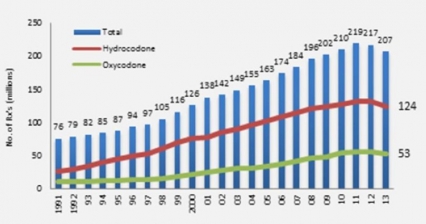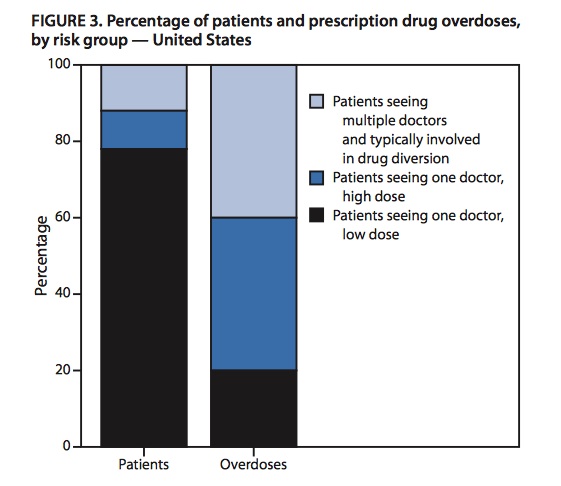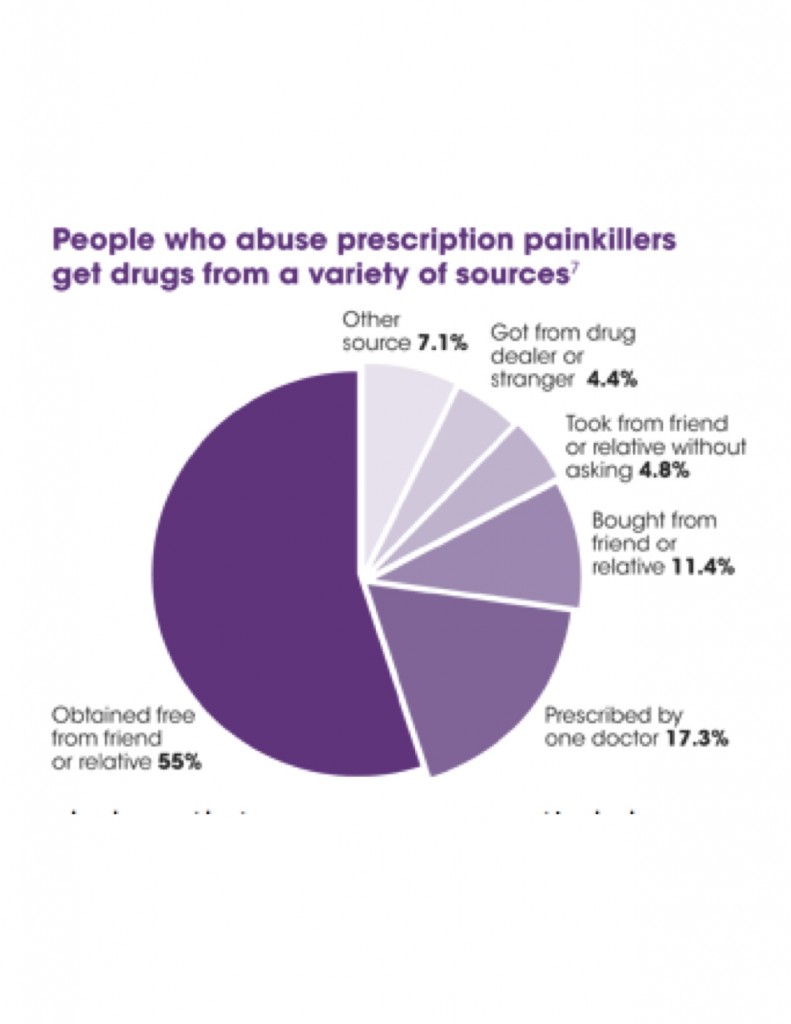Why does there continue to be so much controversy surrounding painkillers?
Painkillers…..Facts:
* High-income countries accounted for nearly 93% of medical morphine consumed in the world, but comprised only 17% of the total population. Low and middle-income countries, representing the remaining 83% of the world’s population, consumed a mere 7% of the total morphine consumption.
* The United States makes up only 4.6 percent of the world’s population, but consumes 80 percent of its opioids — and 99 percent of the world’s hydrocodone (a morphine-like opiate used in painkillers like Vicodin & Lortab).
* In 2010, the United States was the main consumer country of morphine; with consumption of 22.9 tons, it accounted for 55 per cent of global consumption of morphine followed by the United Kingdom (3.5 tons, or 8 percent of the world total), France (2.2 tons, or 5 percent), Germany and Canada (both 1.8 tons, or 4 percent) and Austria (1 ton, or 2 percent).
* Global manufacture of hydromorphone (Diluadid) increased sharply during the last 20 years, reaching 4.3 tons in 2010. The United States (75 percent of global manufacture) and the United Kingdom (14 percent) were the leading manufacturing countries in 2010.
There are 2 basic opposing beliefs at the root of the painkiller controversy:
First Belief:
According to the CDC, the exponential increase (~700%) in consumption of opioids in the U.S. over the past 15 years has led to an epidemic of opioid analgesic overdose deaths and addiction. Canada and Australia have experienced very similar trends. This is an epidemic largely caused by aggressive treatment of chronic non-cancer pain with opioids… a practice that is promoted by drug companies and by the pain groups they fund. Clearly, many individuals consuming prescription opioids in nations with the highest consumption are being harmed by opioids rather than helped. A truly balanced view is one that also finds trends on over-consumption of opioids to be a “grim statistic”. Both under-consumption and over-consumption can cause suffering.
Second Belief:
Almost everyone wants to avoid the experience of severe pain personally and for their loved ones. The reality is that most of humanity does not have that luxury. We know that a very small number of countries consume the great majority of opioids. One just has to walk into most any hospitals in the U.S. to see that pain in our own country is not well controlled…. What does this mean for the others, like Japan or Nigeria? The answer… lots of untreated pain. All these countries have people who have painful acute and chronic illnesses, sustain traumatic injuries, and require surgery. The least fortunate of these people have access to very small quantities of opioids if any, many times the weaker ones like codeine or tramadol. They often use NSAIDs and acetaminophen (paracetamol) with all the inherent morbidity and mortality of these supposedly safer drugs. So what is the problem? Opiophobia, lack of affordable, reliably-produced opioids for manufacturing and political reasons, restrictive drug laws, lack of education for doctors, pharmacists, nurses, and in some places, the lack of a coordinated health care system itself. It truly will take a village, or maybe one big interdisciplinary team, to improve access to opioids and palliative care at home and around the world.
WHICH BELIEF DO YOU SUPPORT?
Further Controversy and Complication
Without question our nation is facing a worsening opioid prescription medication crisis.
We currently manufacture 20 billion tablets of only hydrocodone (Vicodin) and oxycodone (OxyContin) prescription painkillers (that’s just two types of opioids) annually to fill U.S. health care provider’s 259 million prescriptions for opioid painkillers in 2012 alone. This results in our Opioid Overdose epidemic. The overwhelming response is to react with a War on Opioids.

Controversy and complication is created by failing to report ALL the pertinent facts.
The 2 charts below clearly show the vast majority of opioids are being prescribed safely (80% of patients being prescribed low doses of opioids by a single practitioner). This largest group of opioid users account for an estimated 20% of overdoses.

The next group of opioid users (10% of patients) represents high doses of opioids being prescribed by a single practitioner. This group of opioid users account for an estimated 40% of overdoses.
The remaining 10% of patients are of greatest concern. These are patients who seek care from multiple doctors and are prescribed high daily doses, and account for another 40% of opioid overdoses.
Persons in this third group, despite being only 10% of the total, not only are at high risk for overdose themselves but are likely diverting or providing drugs to others who are using them without prescriptions (non-medical users).
In fact, 76% of non-medical users report getting these drugs that had been prescribed to someone else, and only 20% report that they acquired the drug from their own doctor.
Furthermore, among persons who died of opioid overdoses, a significant proportion did not have a prescription in their records for the opioid that killed them; in West Virginia, Utah, and Ohio, 25%–66% of those who died of pharmaceutical overdoses used opioids originally prescribed to someone else.

The aforementioned suggest our War on Opioids should be specific in order to be effective and fair.
Prevention of opioid overdose deaths should focus on strategies that target:
1) high-dosage medical users
2) persons who seek care from multiple doctors, receive high doses, and likely are involved in drug diversion.
The ongoing bitter, anti-opioid campaign waged by some prominent academic institutions, pharmaceutical companies, professional organizations, and journals, almost in unison seem to omit the above facts. Disclosure of such facts does not fit their narrative that opioids shouldn’t be prescribed long term as they are unproven and unsafe calling for restricted opioids for all.
The following are links to read more:
CDC Prescription Drug Overdoses-a U.S. Epidemic
CDC Prescription Painkiller Overdoses Policy
You can also click on the mypainweb “Opioid Truths” to learn more.
Isolated. Depressed. Frustrated. Alone. Misunderstood. Hopelessness.
These insidious feelings are what helps to keep the painweb hidden from plain site. Though they are difficult to readily see, they weave an intricate pattern of damage over time that intensifies pain while further deteriorating quality of life.
Years of struggle has led me to this one simple word, one simple thought…..connect.
I realized I was no longer connected to anybody, or anything. mypainweb was connected; making decisions and calling the shots.
Making a conscious effort to connect is the first small step in the right direction. Taking this first step will lead to more small steps, creating momentum that gradually will make a difference.
Connecting allowed me to see things in a new perspective. While it didn’t fix anything, it did make me realize I owned mypainweb. mypainweb no longer owned me.
Right now as you read mypainweb we are connecting. Though we don’t know each other you are helping me, as I hope in return, I am helping you.
It is estimated that 100 million Americans suffer from chronic pain according to the National Centers for Health Statistics (2010/11). Add two loved ones for every patient and the total number of people affected is at least 228 million American–well over 60% of the population.
Fighting Back is connecting. Re-connecting. Those who suffer chronic pain need to connect to each other.
How? Post any feedback you may have to mypainweb feedback or connect to any internet message board and, or patient site. Here are just a few:
- The Spine-Health Forum
- Chronic Back Pain Support
- Back Problems Message Board
- Spine Surgeon Open Forum
- NueroTalk: Spine Disorders & Back Pain
Remember, the internet is an excellent source to help you take action of your healthcare. The following new website from Public Health Corps is an example of such an empowering website:
Search the mypainweb “Links” and the internet for the topic of your choice and connect.
Use mypainweb “Ask Me” to forward your specific question, thought or concern directly to me.
Share your painweb, or a piece of it and watch what happens.